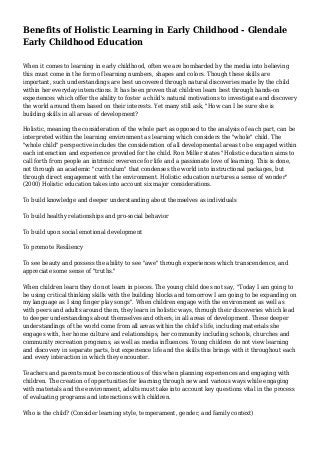
Benefits of Holistic Learning in Early Childhood - Glendale Early Childhood Education
- 1. Benefits of Holistic Learning in Early Childhood - Glendale Early Childhood Education When it comes to learning in early childhood, often we are bombarded by the media into believing this must come in the form of learning numbers, shapes and colors. Though these skills are important, such understandings are best uncovered through natural discoveries made by the child within her everyday interactions. It has been proven that children learn best through hands-on experiences which offer the ability to foster a child's natural motivations to investigate and discovery the world around them based on their interests. Yet many still ask, "How can I be sure she is building skills in all areas of development? Holistic, meaning the consideration of the whole part as opposed to the analysis of each part, can be interpreted within the learning environment as learning which considers the "whole" child. The "whole child" perspective includes the consideration of all developmental areas to be engaged within each interaction and experience provided for the child. Ron Miller states "Holistic education aims to call forth from people an intrinsic reverence for life and a passionate love of learning. This is done, not through an academic "curriculum" that condenses the world into instructional packages, but through direct engagement with the environment. Holistic education nurtures a sense of wonder" (2000) Holistic education takes into account six major considerations. To build knowledge and deeper understanding about themselves as individuals To build healthy relationships and pro-social behavior To build upon social emotional development To promote Resiliency To see beauty and possess the ability to see "awe" through experiences which transcendence, and appreciate some sense of "truths." When children learn they do not learn in pieces. The young child does not say, "Today I am going to be using critical thinking skills with the building blocks and tomorrow I am going to be expanding on my language as I sing finger play songs". When children engage with the environment as well as with peers and adults around them, they learn in holistic ways, through their discoveries which lead to deeper understandings about themselves and others, in all areas of development. These deeper understandings of the world come from all areas within the child's life, including materials she engages with, her home culture and relationships, her community including schools, churches and community recreation programs, as well as media influences. Young children do not view learning and discovery in separate parts, but experience life and the skills this brings with it throughout each and every interaction in which they encounter. Teachers and parents must be conscientious of this when planning experiences and engaging with children. The creation of opportunities for learning through new and various ways while engaging with materials and the environment, adults must take into account key questions vital in the process of evaluating programs and interactions with children. Who is the child? (Consider learning style, temperament, gender, and family context)
- 2. What is the child's community (If the adult is not apart of the family, this might take asking parents and caregivers about community events and places they come in contact with) What are the child's interest (This requires time to observe and reflect on the interactions the child engages in) These questions are used to be certain all areas within the child's context of learning are being met. By planning for holistic means of engagement, parents and teachers allow the child to feel confident, and provide for the ability to master skills, as the "pressure" to attain specific outcomes are diminished. Through the use of open ended materials, parents and teachers offer the child the opportunity to explore, to ask, to wonder and grow with each and every experience. Leading high quality organizations and early childhood programs have noted the importance within the holistic approach to learning. Miller notes "The art of holistic education lies in its responsiveness to the diverse learning styles and needs of evolving human beings" (2000). Through consideration of the cultural diversity present within this country, as well as the unique learning styles and interests of the young children in your life, consider engaging not in parts or lessons but through the image of the "whole child". By doing so you honor the child for who they are and what they have to offer each interaction You honor their unique individuality but most importantly, you honor their desire to feel accepted and included. These positive experiences within learning will transcend to all later learning, allowing for confidence to be build through the deeper understanding of who they are and all that they have to offer others throughout their lives. Links to Holistic Organizations: AERO: Alternative Education Resource Organization AllPIE: Alliance for Parental Involvement in Education Association of Waldorf Schools of North America Down to Earth Books Education in Search of Spirit EnCompass: Center for Natural Learning Rhythms Folk Education Association of America (FEAA) Great Ideas in Education Home Education Magazine John Dewey Project on Progressive Education Montessori Foundation Rethinking Schools Schools Demonstrating Elements of Holistic Education in California:
- 3. Play Mountain Place (Los Angeles, California, USA) Venice Hill School (Visalia, California, USA) References Miller, Ron. (2000). A brief introduction to holistic education. http://www.infed.org/biblio/holisticeducation.htm National Association for the Education of Young Children http://www.naeyc.org/ Holisitc Education Inc. http://holistic-education.net/ http://www.examiner.com/article/benefits-of-holistic-learning-early-childhood